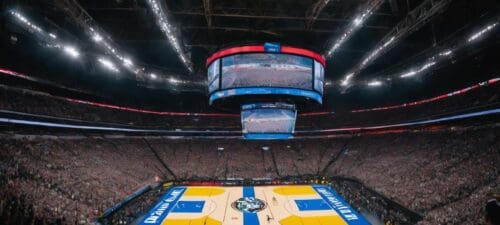Pro Player Contract Basics: Essential Guide for Professionals
Updated On: October 23, 2025 by Aaron Connolly
Core Elements of Player Contracts
Most player contracts in pro sports share a handful of core pieces, no matter the league or game. These documents lay out the job details, spell out legal responsibilities, and lock in the relationship between the player and the team.
Contract Structure and Format
Teams usually stick to a pretty standard employment contract, but they tweak things for each sport. Right at the top, you’ll see the basics—player’s name, position, and the team’s official info.
The contract structure breaks down into several main sections. Duration comes up early on, setting start and end dates. Pay details follow, covering base salary, bonuses, and any incentives tied to performance.
Standard contract sections include:
- Party identification and signatures
- Term length and renewal options
- Compensation and payment schedules
- Performance expectations and metrics
- Termination conditions and procedures
Many teams just use templates that their governing bodies have already approved. FIFA, for example, forces football contracts to include certain clauses. Different leagues throw in their own required language too.
Esports contracts are going digital more often now. They’re just as legally binding as paper ones, but you can sign and process them much faster.
Key Legal Components
You’ll find legal elements in every player contract that make them stick. Consideration is a big one—the player brings their skills, and the team brings the money and the opportunities.
Termination clauses lay out exactly when and how a contract can end. You’ll see reasons like bad performance, misconduct, injury, or mutual agreement. Some contracts even have relegation clauses that change the terms if a team drops down a division.
Essential legal provisions:
- Dispute resolution procedures
- Governing law and jurisdiction
- Confidentiality requirements
- Image rights and commercial usage
- Non-compete restrictions
Performance expectations need to be specific and measurable. If a contract just says “best efforts,” that’s a recipe for arguments later. It’s way better to have clear targets, like minimum training hours or required tournament appearances.
Breach conditions spell out what counts as breaking the contract. Missing practice, public scandals, or playing for a rival team without permission all show up on that list.
Personal Service Contract Nature
Player contracts fall under personal service agreements, so teams can’t just transfer them around without the player’s okay. Teams want people for their unique skills, not just anyone.
You’ll notice these contracts often restrict what players do outside the game. A lot of them ban risky sports, outside tournaments, or anything that could cause injuries. It’s all about protecting the team’s investment.
Personal service elements include:
- Exclusive performance rights during contract term
- Personal conduct and behaviour standards
- Health and fitness maintenance requirements
- Availability for training and competitions
If a player can’t perform anymore, the contract usually ends. But injury clauses sometimes keep paying the player while they recover.
Some deals toss in loyalty bonuses for finishing the full contract. Others boost pay if the player hits certain milestones or performance goals.
Teams also address who owns the rights to content, streaming, and branding. If a player’s big on Twitch or YouTube, the contract will make sure it doesn’t clash with team obligations.
Understanding Base Salary
Base salary sits at the center of every pro player’s contract. It’s what you get just for being rostered. Teams pay it out in weekly chunks during the season, but honestly, it’s not always the safest part of a player’s income.
Determining Base Compensation
Teams look at a bunch of factors to set base salary during negotiations. League minimums create a floor, and those numbers usually go up with more years in the league.
Veterans pull in higher base pay because they’ve already proven themselves. Rookies usually start at the minimum, while established stars can negotiate hefty base salary deals.
Market demand definitely matters. Players in high-need positions usually snag bigger salaries than those in less critical spots.
Performance history plays a huge role too. If you’re coming off a great season, you’ve got more leverage for a raise.
Team salary cap space also shapes offers. If a club’s tight on cap room, they might go lower on base salary but make up for it with bonuses or incentives.
Payment Frequency and Terms
Most leagues pay base salary in weekly installments during the season. Players typically get 18 equal payments—one for each game week and a bye week.
You only get base salary while you’re on the roster. If a team cuts you mid-season, future payments stop unless you’ve got guarantees in your contract.
Guaranteed base salary helps protect players from being cut. Teams have to pay out the guaranteed amount even if they release the player early.
If your base salary isn’t guaranteed, you lose the rest the second you’re off the team.
Some contracts bump up base salary each year. That rewards players for sticking around and gives teams some cost certainty down the line.
Incentives and Bonuses
Most pro contracts throw in extra pay for hitting certain goals. These incentives push players to perform and reward big achievements.
Performance-Related Bonuses
Performance bonuses tie straight to what a player does on the field or in the game. Teams use them to drive specific behaviors and recognize standout play.
Statistical achievements are the bread and butter for performance bonuses. In football, you might see bonuses for goals, assists, or clean sheets. Basketball contracts might pay extra for rebounds, assists, or shooting percentages.
Playing time incentives pop up a lot too. Baseball deals often pay out for appearances. A player could get £10,000 for every 10 games started, or more for hitting 50, 75, or 100 appearances.
Team success bonuses kick in when the team does well. Players get more if they reach playoffs, win championships, or qualify for big tournaments. It’s a nice way to align individual motivation with team goals.
Heads up: If the bar’s set too high, performance targets can backfire and frustrate players.
Signing and Roster Bonuses
Signing bonuses give players a pile of cash upfront when they join a new team. It’s guaranteed, so you get it no matter what happens later.
Signing bonuses mean a lot for top-tier athletes. A £2 million bonus isn’t just a nice payday—it shows the team is serious about you.
Roster bonuses pay out if you’re still on the team at a certain date. Maybe you get £500,000 on April 1st if you haven’t been cut. It keeps players loyal and gives teams some wiggle room.
Reporting bonuses nudge players to show up for training camp or preseason on time. Miss those dates, and you could lose thousands.
Teams and players both like these bonuses because they often don’t count against the salary cap.
Loyalty and Endorsement Incentives
Long-term perks reward players for sticking around and boosting the team’s brand.
Loyalty bonuses pay more the longer you stay. You might see escalating bonuses for finishing your second, third, or fourth season with the same team.
Conduct bonuses hand out extra cash for professionalism and community work. If you keep a clean record, help with charity, or represent the team well in the media, you can earn more.
Endorsement protections make sure players get paid fairly when their image is used for marketing. These clauses lay out how royalties are split and guarantee pay for promo work.
Weight and fitness bonuses help keep players in shape. Some contracts pay for hitting fitness targets or maintaining a certain weight.
These incentives work for everyone. Teams get committed, pro players, and athletes have more ways to earn.
Tournament Winnings and Revenue Sharing

Tournament prize money gets split up between teams and players based on whatever the contract says. Usually, the org takes a cut and the rest gets divided among the players, depending on their roles and how they performed.
Allocation of Prize Money
Prize pools get carved up differently depending on the tournament. Solo events like fighting games or poker give the whole prize to the winner. Team-based esports like League of Legends or CS2 split the pot among all the team members.
Most big tournaments use a tiered payout. The champs might take 40% of the prize pool, second place grabs 20%, and third gets 15%. If you finish lower, you might get a smaller slice or nothing.
Some events hand out bonuses for hitting certain stats or milestones. That way, players have extra motivation to perform even if their team isn’t winning it all.
Team and Organisation Shares
Most esports orgs take 15-30% of tournament winnings from their players. That covers team expenses, coaches, and the cost of running things.
The more the team provides—like housing, coaching, or gear—the bigger their cut. If a player supplies their own equipment and trains solo, they might negotiate a smaller percentage.
| Team Investment Level | Typical Organisation Share |
|---|---|
| Full support (house, coach, equipment) | 25-30% |
| Partial support (coaching only) | 15-20% |
| Minimal support (tournament entry fees) | 5-10% |
Longer contracts often mean the org gets a bigger share.
Distribution Amongst Players and Staff
Inside teams, prize money usually gets split evenly among all players, especially in games like Valorant or Dota 2. Some orgs set aside a bit for subs and coaches, too.
Star players sometimes negotiate a bigger slice if their contract allows it—maybe for MVP awards or standout stats.
Support staff like analysts and managers usually get fixed bonuses instead of a percentage. A typical breakdown: 70% to players, 20% to the org, 10% to coaches and analysts.
Pro tip: Always sort out your prize money split before you sign anything. There are standard rates, but if you’ve got leverage, negotiate.
Negotiating Your First Professional Contract
Nailing your first pro contract is a big deal. It sets the tone for your whole esports career. If you know your worth—thanks to performance stats and market research—you’ll have a lot more power to get fair pay, good incentives, and the right contract length.
Assessing Player Value
Your value isn’t just about your rank or how many trophies you’ve won. Teams look at the whole package when they’re deciding what to offer.
Performance metrics matter most. Track your kill/death ratio, win rate, and your consistency in tournaments. Keep screenshots and records of your best moments and how you’ve improved.
Streaming numbers add value. Got a Twitch or YouTube following? That’s a big plus for teams looking for extra exposure. Make sure you know your average views and subscriber growth.
Age and potential for growth play a role, too. Younger players sometimes get lower base pay but better development opportunities and longer deals.
Skills outside the game count as well. Communication, leadership, and how you mesh with teammates all factor in. Teams want players who make the whole squad better.
It helps to have all your stats and achievements documented. That way, you’re not just making vague claims in negotiations.
Market Comparison Strategies
Do your homework before you negotiate. If you know what others are making, you’re less likely to undersell yourself.
Look at players with similar experience. Compare what players like you are getting, especially those who joined teams at the same stage in their careers. Pay attention to base salaries and incentive setups.
Check out recent signings in your game and region. Salaries in CS2, League, and Valorant can be wildly different.
Use more than one source for salary info. Try esports earnings sites, social media announcements, and industry reports for benchmarks.
Consider the team’s budget tier too. Tier-one orgs pay differently than smaller outfits, even for similar talent.
Don’t forget about perks beyond salary. Some teams offer better gear, travel money, or coaching, which can make a big difference in your overall contract package.
Navigating Offer and Counteroffer
Don’t jump at the first offer, even if it looks solid. Teams usually expect you to negotiate and often start with a lowball number.
Ask for time to review any offer. Always request at least 48 hours so you can really look over the terms and think things through. It’s professional and gives you breathing room.
Focus on the most important terms first. Base salary, contract length, and performance incentives usually matter more than smaller perks.
Prepare your counteroffer with care. Lean on your market research to back up any salary increase requests. Explain why your skills and potential deserve better terms.
You’ll probably have to compromise somewhere. Maybe you accept a lower base salary for better bonuses or streaming rights.
Decide your walk-away point before you start negotiating. If you’ve got other options or you’re willing to wait, you’ll have a lot more leverage.
Duration, Renewal, and Exit Clauses

These clauses spell out how long contracts last and how players or teams can end things. They set the ground rules for extensions, terminations, and financial obligations when contracts end early.
Contract Length and Extensions
Most pro esports contracts run for one to three years. Shorter deals give players more flexibility to renegotiate as their value goes up.
Teams often add option clauses that let them extend contracts for extra years. That way, they don’t lose top talent too soon and get time to see how players perform.
Automatic renewal clauses can kick in unless either side gives notice. Usually, there’s a 30 to 90-day notice period before contracts expire.
Extension talks usually happen in the final year. Players with strong stats can push for better terms or shorter deals.
Teams sometimes offer performance-based extensions that trigger if players hit certain goals. Tournament wins, personal stats, or team placements all count.
Termination Conditions
Contracts lay out the situations where either side can end things early. If players break team rules or miss performance standards, that’s a breach of contract and grounds for termination.
Common reasons include:
- Poor performance for months on end
- Behavioural issues like toxicity or skipping training
- Health problems that stop you from competing
- Mutual agreement to part ways
Notice periods usually fall between 30 and 90 days for standard terminations. In emergencies, immediate termination can happen if there’s proper paperwork.
If teams terminate without cause, they typically pay out the remaining salary. Players who quit early might lose bonuses or face penalties.
Release and Buyout Clauses
Release clauses set a fee that other teams must pay if they want to sign a player before their contract ends. This stops teams from blocking transfers for no good reason.
Buyout clauses are a bit different—they let teams release players early by paying a set amount. That gives teams flexibility and compensates players for lost earnings.
Buyouts usually range from 25% to 100% of what’s left on the contract. Star players often push for higher percentages to discourage early releases.
Transfer windows can limit when release clauses are in play. Many esports stick to sports-style calendars for player movement.
Some contracts include declining buyout clauses where the fee drops over time. This helps balance team investment and player mobility.
Legal Representation and Player Advocacy

Pro players really need expert legal support to handle complicated contracts and protect themselves. Good agents and lawyers make sure negotiations are fair and players’ rights stay protected.
Role of Agents and Lawyers
Sports agents take care of contract negotiations, endorsement deals, and career management for players. They act as the go-between for players and organisations.
Key responsibilities include:
- Negotiating salary, bonuses, and incentives
- Landing endorsement contracts with brands
- Managing media appearances and PR
- Planning long-term career growth
Lawyers who know sports law bring crucial legal skills. They check contract terms, spot risks, and make sure everything lines up with league rules.
Sports attorneys work to protect players from unfair clauses. They look closely at release clauses, injury provisions, and termination details.
Heads up: Some rookie agents promise the moon to get clients. Always check an agent’s track record and client list before signing anything.
Quality legal help costs about 3-10% of your contract. It’s an investment that can save you from expensive mistakes down the line.
Ensuring Fair Negotiations
You need to come prepared and know the market for fair contract talks. Agents research salaries, performance stats, and industry standards for comparison.
Effective negotiation strategies include:
- Comparing similar player contracts
- Highlighting your unique skills and achievements
- Structuring performance-based incentives
- Adding injury protection clauses
Legal reps make sure contract terms are fair and enforceable. They check payment schedules, performance requirements, and disciplinary rules.
Player advocates push for solid medical coverage and insurance for career-ending injuries. These are critical for financial security after your playing days.
Quick tip: Ask for a few contract options during negotiations. This gives you flexibility and shows you’re prepared.
Good legal teams also negotiate education clauses and post-career training options. It’s smart to think about life after gaming.
Rights, Obligations, and Conduct Clauses

Pro contracts lay out strict rules for what players must do and what’s off-limits. Teams use these clauses to protect their brand and keep control over player behaviour both online and offline.
Player Duties and Team Rules
Players follow team schedules and practice requirements. Most contracts demand 8-12 hours of practice daily during the season.
Teams are strict about attendance and being on time. Miss a practice or meeting, and you might get fined £100 to £1,000 per incident.
Media obligations are just part of the job now. That means:
- Post-match interviews
- Social media posts for sponsors
- Showing up at fan events
- Streaming (often 20+ hours a month)
Players have to look after their health. Many contracts require regular medical check-ups and mental health assessments.
Equipment and uniform rules aren’t up for debate. Players use team-approved gear and can’t modify peripherals without permission.
Some teams limit what players can stream on their own. You can’t stream competitor games or use unauthorised sponsors on your personal channel.
Non-Compete and Exclusivity Provisions
While under contract, pro players can’t compete for other teams. This covers amateur tournaments and even some casual events.
Exclusivity clauses stop players from:
- Joining more than one team
- Competing in rival leagues
- Coaching competitors
- Sharing team strategies
Most contracts have non-disclosure agreements. Players can’t leak team tactics, roster changes, or internal drama to the media or fans.
Post-contract restrictions usually last 3-6 months. After leaving, you can’t immediately join direct rivals or share sensitive info.
Streaming exclusivity ties you to a platform. If you’re Twitch-exclusive, you can’t stream on YouTube Gaming—even for personal stuff.
Warning: Break an exclusivity clause and you could face instant termination or even legal action.
Some contracts ban players from endorsing rival brands. If you’re sponsored by SteelSeries, you can’t promote Razer products.
Injury Protection and Player Welfare

Gaming contracts now include injury and medical clauses much like traditional sports. Players can get continued salary and solid healthcare coverage if injuries keep them from competing.
Injury Clauses and Salary Guarantees
Modern esports contracts protect players with guaranteed salary during injury periods. Most teams pay base salary for 3-6 months if a player can’t compete due to injury.
Fully guaranteed contracts offer maximum protection. Players get their full contract value, injury or not. Usually, only stars or franchise players land these deals.
Partially guaranteed deals only cover certain parts of the contract. The guaranteed amount is usually 40-70% of total earnings. Teams can end the rest if injuries keep players sidelined.
Many contracts add injury settlement clauses for lump-sum payments when teams release injured players. The amount depends on the contract’s length and what’s still guaranteed.
Players should ask for medical clearance requirements so teams can’t release them until a doctor gives the green light.
Insurance Provisions and Medical Support
Pro esports teams now offer comprehensive medical coverage through team insurance. This includes physiotherapy, ergonomic assessments, and specialist care for gaming injuries.
Team-sponsored healthcare covers regular health checks, mental health support, and preventive care programs. Most teams budget £2,000-5,000 per player each year for medical costs.
Insurance often covers career-ending injury compensation with extra payments beyond contract guarantees. These usually pay 1-2 times your annual salary for permanent disabilities.
Many players buy personal disability insurance to fill any gaps in team coverage. Policies cost £500-2,000 a year but are worth it for peace of mind.
Teams now offer wellness programmes—ergonomic gear, regular physio, and mandatory rest—to help prevent injuries from happening in the first place.
Post-Contract Career Planning

Smart players start thinking about their future while still competing. Building education credentials and looking at post-playing options helps make that transition a lot smoother.
Ongoing Education Opportunities
Most pro gaming careers peak between 18 and 25. That leaves a lot of working years ahead. Savvy players invest their earnings in education to open doors later.
Universities now offer esports business programmes and sports management degrees. You can learn marketing, event management, and team operations—often part-time or online to fit around training.
Popular education paths include:
- Digital marketing certificates
- Business management diplomas
- Broadcasting and media courses
- Sports psychology qualifications
- Computer science degrees
Some players go for coaching badges from groups like the British Esports Association. Others pick up video editing, graphic design, or streaming production. These skills work well in the esports industry.
Start early. Don’t wait until you retire to hit the books.
Transitioning to Post-Playing Roles
Ex-pros have unique advantages in the esports job market. Your experience opens doors that others can’t even knock on.
High-demand roles for ex-players:
- Team coaches and analysts
- Tournament commentators and hosts
- Content creators and streamers
- Esports journalists and reporters
- Community managers for gaming brands
Coaching pays £25,000-£60,000 for established teams. Many start with amateur squads to get experience.
Broadcasting can pay well, but it’s competitive. Start building content and a following while you’re still playing.
Content creation gives you flexibility. Top streamers make money through sponsorships, donations, and partnerships, but only a few do it full-time.
Networking matters. Stay in touch with teammates, coaches, and industry folks—they’ll remember you when opportunities pop up.
Sponsorships and Independent Earnings

Pro players don’t just rely on their team contracts for income. They often pull in significant money through individual sponsorships and by making content online.
These extra revenue streams can actually offer more long-term financial stability than just team salaries.
Independent Sponsorship Agreements
Players can work out their own sponsorship deals, totally separate from whatever their team has going on. Usually, these deals involve gaming gear brands, energy drink companies, or lifestyle brands that want to reach gamers.
Individual sponsorships come with some real perks:
- You can earn a lot more personally
- You get to pick your own brand partners
- There’s flexibility to choose sponsors that actually fit your vibe
Compensation looks different for everyone. If you’re just starting out, you might get free products worth £500–£2000 a year. Once you’re established, deals can jump to £10,000–£100,000+ depending on your following and how you perform.
Heads up: Always read through contract terms. Some sponsors want exclusivity, which could mess with your team’s deals.
Make sure you handle image rights separately from team contracts. That way, you keep control over your personal brand and social media. A lot of rookies miss this detail.
Streaming and Content Revenue
Platforms like Twitch and YouTube have become goldmines for pro players. Some top streamers end up making more from content than from actual competition.
Main ways to earn:
- Subscriptions (usually £2–5 per subscriber each month)
- Viewer donations
- Ad revenue
- Sponsored content
If you want to build a streaming career, you’ve got to create content consistently. Most successful pros stream 20–40 hours a week during the off-season.
Quick tip: Stream your practice sessions and tournament prep. That way, you grow your audience without losing your competitive edge.
Content creation takes time. Most players need 6–12 months of regular streaming before they see steady income. But if you’re already well-known, you might grow faster.
Platforms like Twitch and YouTube offer partner programs. Partners get better revenue shares and cool features to help engage their audience.
Frequently Asked Questions

Professional player contracts cover a lot: salary, injury protection, trade clauses, and more. Teams and players agree on guaranteed pay, bonuses, contract length, and legal protections.
What are the standard terms included in a professional player’s contract?
Every pro player contract lays out some basics—salary, contract duration, and employment terms.
Guaranteed pay is standard, so you’ll get a minimum amount no matter how you perform. You’ll also see obligations like attending practice and doing promo events.
Most contracts have injury clauses to protect both sides. These explain what happens if you get hurt and can’t play.
Contracts include restricted free agency clauses, which control if and when you can switch teams. Trade clauses spell out when and how a team can move you.
How does salary structuring work for pro athletes?
You won’t see just a single payment for salary. Teams break it down into several pieces.
Your base salary is what you get each season, paid out in regular instalments.
Signing bonuses are one-off payments you get for signing the contract. Teams use these to attract top players, and they’re separate from your usual pay.
Performance bonuses reward you for hitting certain goals—like scoring, team wins, or grabbing an MVP award.
Some deals have roster bonuses. If you’re still on the team at certain dates, you get extra cash. These help teams keep players locked in for the full contract.
Can you explain the typical duration and extension options for a player’s contract?
Contract length really depends on the sport, league, and your experience. Most last one to five years. If you’ve been around for a while, you can usually land longer deals.
Guaranteed money is a big deal. That’s what you’ll get even if you get hurt or released early.
Teams sometimes put options in for extra years. This lets them keep you around at preset terms, but you don’t get to decide.
Player options work the other way. You can choose to extend your deal or hit free agency. Stars with leverage usually get these.
Teams usually start talking about extensions in your last contract year. They want to keep key players before free agency rolls around.
What are the common performance incentives found in these types of contracts?
Teams use incentives to reward great play and team wins. These bonuses can really add to your earnings.
Individual bonuses are the most common. If you hit certain stats—like goals, games played, or defensive markers—you get paid.
Team success bonuses tie your pay to how the squad does. Making playoffs, winning championships, or hitting certain league spots can trigger these.
Awards-based bonuses pay out if you win things like MVP or All-Star. Only the top players usually get these.
Playing time bonuses pay you for being on the field a lot. You might get one if you play a certain percentage of matches or minutes.
Heads up: Sometimes the targets for these bonuses are way too high. Make sure you can actually hit them before you sign.
How is a player’s contract affected if they are traded to another team?
If you get traded, your contract usually goes with you—same pay, same bonuses, same length.
Some contracts have no-trade clauses. If you’ve got one, you can say no to certain moves. Only established stars usually get these.
Trade bonuses sometimes show up too. If you get moved, you get extra money for the hassle.
Your new team takes on all contract obligations, including guaranteed money and bonuses. The old team can’t just walk away from those.
If your contract has location-specific terms, you might need to renegotiate with the new org after a trade.
What legal protections are afforded to players under a professional contract?
Professional player contracts give you several legal safeguards that look out for your interests during the agreement. Honestly, these protections usually go beyond what you’d see in a regular job contract.
Athletes deal with higher injury risks, so workers’ compensation coverage tends to be more thorough. That way, if you get hurt while playing, you can actually count on proper medical care and some financial support.
Disability insurance can help protect your long-term earning potential if you suffer a career-ending injury. A lot of contracts throw in clauses for ongoing payments in those tough situations.
If you and the team clash over something, grievance procedures kick in to sort out disputes. They set up a formal way to address contract violations or arguments about the terms.
If there’s union representation, you get another layer of legal protection through collective bargaining agreements. These set minimum standards and ways to resolve disputes for everyone in the league.
Quick win: Before you sign anything, have a qualified sports lawyer look over your contract. They might spot issues or suggest tweaks that really protect your interests.








